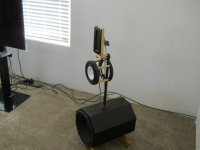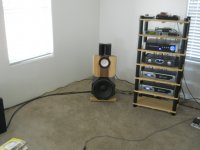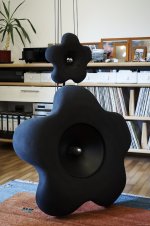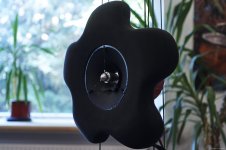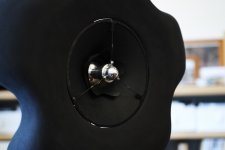Here is my experience - I did a no baffle OB speaker and the measurements were severely lacking in the lower midrange. I then found the formula to calculate the baffle step - 4,560 / baffle in. = baffle step cutoff. I did a simple 13 in. baffle for midrange and it comes out to 350 hz which is about where I course to the bass driver. It is the best sounding system I have ever built. It is fully active which allows me to address any holes in the frequency response. The 1st picture was the no baffle iteration. The 2nd picture is the current system.
Attachments
Hi Whacky,
They were and are a compromise, but one I would still choose today, if I would need to do it all again. The Black Flowers are the culmination of many years of experience. The compromises are the balance between extremes:
- No baffle is relatively easy, but a certain size is more efficient.
- To keep things relatively simple, two ways should be enough. 18" and 8" are fine and loud enough. Of course it´s no dipole.
- To avoid baffle effects as far as possible, I made the baffles so that their impact is at minimum.
- Free swinging is always great, but you´ll have to keep an eye on mass relations.
- A relatively simple 2-way speaker allows the implementation of a passive filter of very high quality. No need for dsp.
- 18" bass driver, even in baffle, is always a compromise between bass reach, efficiency and baffle size. There´s no way out.
But then, I hope that I don´t need to do it again, it was a nightmare in my workshop... now I hate even the idea to route or sand black EVA...
All the best
Mattes
They were and are a compromise, but one I would still choose today, if I would need to do it all again. The Black Flowers are the culmination of many years of experience. The compromises are the balance between extremes:
- No baffle is relatively easy, but a certain size is more efficient.
- To keep things relatively simple, two ways should be enough. 18" and 8" are fine and loud enough. Of course it´s no dipole.
- To avoid baffle effects as far as possible, I made the baffles so that their impact is at minimum.
- Free swinging is always great, but you´ll have to keep an eye on mass relations.
- A relatively simple 2-way speaker allows the implementation of a passive filter of very high quality. No need for dsp.
- 18" bass driver, even in baffle, is always a compromise between bass reach, efficiency and baffle size. There´s no way out.
But then, I hope that I don´t need to do it again, it was a nightmare in my workshop... now I hate even the idea to route or sand black EVA...
All the best
Mattes
Attachments
Apparently minimal drivers in both size/quantity too. 
Doing OB right is the crux of the matter in that it's the inverse of an equivalent 'full range' BLH, hence 'no baffle' beyond driver throat size = driver effective diameter [Sd + end correction] is the ideal, though can fudge a bit re driver only Vs on a small 'stabilizing' baffle.
Doing OB right is the crux of the matter in that it's the inverse of an equivalent 'full range' BLH, hence 'no baffle' beyond driver throat size = driver effective diameter [Sd + end correction] is the ideal, though can fudge a bit re driver only Vs on a small 'stabilizing' baffle.
Last edited:
So this seems to get down to a battle between large baffles vs. no baffles for OB speakers. Being a novice and still trying to decide what to build for my first OB speaker, I keep reading the arguments for both sides.
But being an engineer I also look at the science between the two approaches and frankly the no baffle approach makes no sense. The cancellation of the front and back waves around the edges of a baffle-less speaker seems to rule it out completely. I understand that some people claim it sounds better, but I find that hard to accept.
So for now, at least, my first OB build will be with a baffle and probably short side wings as well. The Manzanita is still at top of my list for that build.
I’m putting my trust in Pano for this discussion and not the other side.
But being an engineer I also look at the science between the two approaches and frankly the no baffle approach makes no sense. The cancellation of the front and back waves around the edges of a baffle-less speaker seems to rule it out completely. I understand that some people claim it sounds better, but I find that hard to accept.
So for now, at least, my first OB build will be with a baffle and probably short side wings as well. The Manzanita is still at top of my list for that build.
I’m putting my trust in Pano for this discussion and not the other side.
^ Yes, I've done that with OK results. A bit complicated, but can work. Generally I just go with as big as I can for the sake of the bass.
I've heard a fair number of O.B. speakers where people talked about the clean, clean bass. Yes, so clean it's non-existent! Maybe they were just hearing the harmonics and filling in the rest with imagination.
I've heard a fair number of O.B. speakers where people talked about the clean, clean bass. Yes, so clean it's non-existent! Maybe they were just hearing the harmonics and filling in the rest with imagination.
So this seems to get down to a battle between large baffles vs. no baffles for OB speakers.
No 'battle', the physics of the situation is clear; if not designed correctly, then baffles are required to make up the difference, so short of bass arrays, a baffle is required below ~300 Hz, the corner frequency of a 15", though prefer TQWT alignments below it.
No 'battle', the physics of the situation is clear; if not designed correctly, then baffles are required to make up the difference, so short of bass arrays, a baffle is required below ~300 Hz, the corner frequency of a 15", though prefer TQWT alignments below it.
Then your earlier statement is very confusing. You said:
"Doing OB right is the crux of the matter in that it's the inverse of an equivalent 'full range' BLH, hence 'no baffle' beyond driver throat size = driver effective diameter [Sd + end correction] is the ideal, though can fudge a bit re driver only Vs on a small 'stabilizing' baffle."
What exactly is a "small stabilizing baffle"?
Designing a good dipole loudspeaker is easy. Study and learn the basics and apply! Each dipole radiator has only 2-3 octaves of usable range, depending on baffle size. This means that you must make it at least 3-way and apply lots of equalization.
Designing and making an open baffle speaker even more easy, just take a random piece of mdf and cut a hole for the random driver you happen to have. Don't even try to make any measurements of response and distotion!
Designing and making an open baffle speaker even more easy, just take a random piece of mdf and cut a hole for the random driver you happen to have. Don't even try to make any measurements of response and distotion!
An externally hosted image should be here but it was not working when we last tested it.
Using a relatively large and efficient woofer with high Qts, reasonable xmax, and low Fs. mate with a slightly less efficient full range driver and crossover appropriately. Size the baffle including wings to support the Q of your woofer and you are pretty much done. There are tweaks but it is amazing how good a simple design can sound. In fact my first OB was a pair of salvaged 8" full ranges of questionable parentage stuch in baffles about 2.5' wide and 3.5" tall. They sounded really good. I stuck a pair of old dome tweeters on top to get the sizzle and they worked quite well for everything but organ music.
The nice thing about OBs beside the sound is that they are so easy to experiment with. My advice is just don't complicate your life by using low Q drivers at first.
The nice thing about OBs beside the sound is that they are so easy to experiment with. My advice is just don't complicate your life by using low Q drivers at first.
I thought the ubiquitous "H frame" design nicely took care of the baffle part for the low frequency driver? Isnt it like 6 "wings"; 3 about the front, 3 about the back - with the floor plane common?
Then you need to balance the xover point to the "next driver up", staying well away from the cavity resonance of the 7-9" deep tub structures. I thought I read Linkwitz even designed a notch filter (3-400Hz) to stomp that out!
One would think it's a matter of choosing the driver (FR for a two way...) that can hit low enough to cross well below the woofer wing cavity resonance - in any design. I can see this being a problem when you want to keep the rear side radiation of the driver wide open, for the speaker to be more than just OB bass.
This means you're restricted to balancing driver size / baffle size / baffle placement to play well with that winged OB woofer restraint. I see back in 2008, MJK did this using a 4" driver. I also understand the Visaton BG20-8 is a darling for OB; perhaps because of its size allows it an easier time to hook up with the woofer crossover frequency.
I also understand winging or framing the next driver up isnt such a good idea, as the cavity resonance will likely have multiple modes... Has anyone done this to reduce the aesthetic baffle size for this driver?
No wings, no tub resonance, but "no bass" also. Choose and balance, make a clever fitting between elements if you can.
Then you need to balance the xover point to the "next driver up", staying well away from the cavity resonance of the 7-9" deep tub structures. I thought I read Linkwitz even designed a notch filter (3-400Hz) to stomp that out!
One would think it's a matter of choosing the driver (FR for a two way...) that can hit low enough to cross well below the woofer wing cavity resonance - in any design. I can see this being a problem when you want to keep the rear side radiation of the driver wide open, for the speaker to be more than just OB bass.
This means you're restricted to balancing driver size / baffle size / baffle placement to play well with that winged OB woofer restraint. I see back in 2008, MJK did this using a 4" driver. I also understand the Visaton BG20-8 is a darling for OB; perhaps because of its size allows it an easier time to hook up with the woofer crossover frequency.
I also understand winging or framing the next driver up isnt such a good idea, as the cavity resonance will likely have multiple modes... Has anyone done this to reduce the aesthetic baffle size for this driver?
No wings, no tub resonance, but "no bass" also. Choose and balance, make a clever fitting between elements if you can.
Using a relatively large and efficient woofer with high Qts, reasonable xmax, and low Fs. mate with a slightly less efficient full range driver and crossover appropriately. Size the baffle including wings to support the Q of your woofer and you are pretty much done. There are tweaks but it is amazing how good a simple design can sound....
That recipe appears to perfectly match the Manzanita design that has been discussed here in another thread at length:
Fast, fun, Inexpensive OB project
Just happened upon this thread and subscribed to it as a result of designing OB baffles for the old and venerable Wharfedale W15FS or CS (foam surround/cloth surround)
I tend to agree with Mr. Bansuri that the infinite baffle is better than no baffle. May I add that a baffle of 57 feet in diameter or on a side if square would suffice by preventing doublet action down to 20hz. The caveat is that in most, if not all rooms, such a baffle, in all practicality, could be considered as infinite for obvious reasons.
IMHO, I see no difference between an OB and dipole as all speakers with a vibrating diaphragm are dipole. A couple of non vibrating diaphragms speakers come to mind. One was the gas flame, into which was placed two wires driven by a high frequency oscillator. By modulating the bias frequency with the audio signal, variations in the ionization of the gas in the flame would create a pressure wave, resulting in sound. Another was the "singing arc" which was a quarts rod inserted along the axis of a horn. Again, a high frequency was modulated by the audio signal with the same result.
Both these devices, considering diaphragm mass only, which was close to zero, the efficiency was close to 100%. However, when one considers the power required to run the oscillators and the heat dissipated by the flame, efficiency went to hell in a handcart, not to mention the risk of fire with the flame.
I seem to recall a more modern attempt at such a device whereby the experimenters used an inert gas, possibly helium with a lot of high tech wizardry to produce sound. It did work but again, somewhat impractical outside a laboratory.
Maybe someday. Consider the laser. Once it took a ton of equipment to produce but today one can buy a key fob powered by a 3 volt battery and drive your dog or cat crazy chasing the red spot. Must be something about that red spot because a flashlight seldom, if ever, produces the same effect.
For more info on the OB units, there are 3 links on this page in my website. The Wharfedale Pages
They are titled as and close to the bottom of the list:
The SFB3
The SFB3 with modern drivers PART 1
The SFB3 with modern drivers PART 2
I tend to agree with Mr. Bansuri that the infinite baffle is better than no baffle. May I add that a baffle of 57 feet in diameter or on a side if square would suffice by preventing doublet action down to 20hz. The caveat is that in most, if not all rooms, such a baffle, in all practicality, could be considered as infinite for obvious reasons.
IMHO, I see no difference between an OB and dipole as all speakers with a vibrating diaphragm are dipole. A couple of non vibrating diaphragms speakers come to mind. One was the gas flame, into which was placed two wires driven by a high frequency oscillator. By modulating the bias frequency with the audio signal, variations in the ionization of the gas in the flame would create a pressure wave, resulting in sound. Another was the "singing arc" which was a quarts rod inserted along the axis of a horn. Again, a high frequency was modulated by the audio signal with the same result.
Both these devices, considering diaphragm mass only, which was close to zero, the efficiency was close to 100%. However, when one considers the power required to run the oscillators and the heat dissipated by the flame, efficiency went to hell in a handcart, not to mention the risk of fire with the flame.
I seem to recall a more modern attempt at such a device whereby the experimenters used an inert gas, possibly helium with a lot of high tech wizardry to produce sound. It did work but again, somewhat impractical outside a laboratory.
Maybe someday. Consider the laser. Once it took a ton of equipment to produce but today one can buy a key fob powered by a 3 volt battery and drive your dog or cat crazy chasing the red spot. Must be something about that red spot because a flashlight seldom, if ever, produces the same effect.
For more info on the OB units, there are 3 links on this page in my website. The Wharfedale Pages
They are titled as and close to the bottom of the list:
The SFB3
The SFB3 with modern drivers PART 1
The SFB3 with modern drivers PART 2
- Home
- Loudspeakers
- Multi-Way
- Open Baffle design preferences
